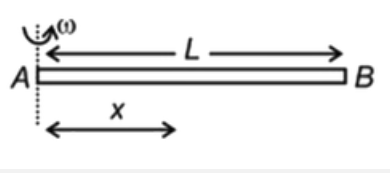An ice skater having moment of inertia l rotating with angular speed ω suddenly opens her arms, which reduces her angular velocity to ω4. Calculate the change in moment of inertia of the dancer.
To solve the problem, we will use the principle of conservation of angular momentum. Here's a step-by-step solution:
Step 1: Understand the conservation of angular momentum
The principle of conservation of angular momentum states that if no external torque acts on a system, the total angular momentum of the system remains constant.
Step 2: Define the initial conditions
Let:
- I1=I (initial moment of inertia)
- ω1=ω (initial angular velocity)
Step 3: Define the final conditions
After the skater opens her arms:
- ω2=ω4 (final angular velocity)
- Let I2 be the final moment of inertia, which we need to find.
Step 4: Apply the conservation of angular momentum
According to the conservation of angular momentum:
I1ω1=I2ω2
Substituting the known values:
I⋅ω=I2⋅ω4
Step 5: Simplify the equation
We can cancel ω from both sides (assuming ω≠0):
I=I2⋅14
Step 6: Solve for I2
Rearranging the equation gives:
I2=4I
Step 7: Calculate the change in moment of inertia
The change in moment of inertia ΔI is given by:
ΔI=I2−I1
Substituting the values we found:
ΔI=4I−I=3I
Final Answer
The change in moment of inertia of the dancer is ΔI=3I.
---
The principle of conservation of angular momentum states that if no external torque acts on a system, the total angular momentum of the system remains constant.
Let:
- I1=I (initial moment of inertia)
- ω1=ω (initial angular velocity)
After the skater opens her arms:
- ω2=ω4 (final angular velocity)
- Let I2 be the final moment of inertia, which we need to find.
According to the conservation of angular momentum:
I1ω1=I2ω2
Substituting the known values:
I⋅ω=I2⋅ω4
We can cancel ω from both sides (assuming ω≠0):
I=I2⋅14
Rearranging the equation gives:
I2=4I
The change in moment of inertia ΔI is given by:
ΔI=I2−I1
Substituting the values we found:
ΔI=4I−I=3I
The change in moment of inertia of the dancer is ΔI=3I.
Topper's Solved these Questions
- BOOK - AAKASH INSTITUTE ENGLISHCHAPTER - SYSTEM OF PARTICLES AND ROTATIONAL MOTIONEXERCISE - Assignment (Section - J) Aakash Challengers Questions13videos
SYSTEM OF PARTICLES AND ROTATIONAL MOTION
- BOOK - AAKASH INSTITUTE ENGLISHCHAPTER - SEMICONDUCTOR ELECTRONICS: MATERIALS, DEVICES AND SIMPLE CIRCUITSEXERCISE - Assignment (Section-D (Assertion and reason))5videos
SEMICONDUCTOR ELECTRONICS: MATERIALS, DEVICES AND SIMPLE CIRCUITS
- BOOK - AAKASH INSTITUTE ENGLISHCHAPTER - TEST 1EXERCISE - EXERCISE21videos
TEST 1
Similar Questions
A torque T acts on a body of moment of inertia l rotating with angular speed ω. It will be stopped just after time
View SolutionA non - conducting rod of length L with linear charge density λ=λ0x where x is the distance from end A is rotating with constant angular speed ω about the same end. If the angular velocity of the rod (ω) is large, then the magnetic dipole moment of the system is ωλ0L4n. What is the value of n?
 View Solution
View SolutionDoes moment of inertia depend upon the angular velocity of the body ?
View SolutionA circular disc of moment of inertia It is rotating in a horizontal plane about its symmetry axis with a constant angular velocity ωi. Another disc of moment of inertia Ib is dropped co-axially onto the rotating disc. Initially, the second disc has zero angular speed. Eventually, both the discs rotate with a constant angular speed ωf. Calculate the energy lost by the initially rotating disc due to friction.
View SolutionThe moment of inertia (I) and the angular momentum (L) are related by the expression
View SolutionA disc of mass m, radius r and carrying charge q, is rotating with angular speed ω about an axis passing through its centre and perpendicular to its plane. Calculate its magnetic moment
View SolutionA disc of mass m, radius r and carrying charge q, is rotating with angular speed ω about an axis passing through its centre and perpendicular to its plane. Calculate its magnetic moment
View SolutionThe moment of inertia of a body moving with angular velocity ω decreases from l to l3 without any external torque. Calculate the new angular velocity of the body.
View SolutionThe moment of inertia of a body moving with angular velocity ω decreases from I to I3 without any external torque. Calculate the new angular velocity of the body.
View SolutionTwo discs of same moment of inertia rotating their regular axis passing through centre and perpendicular to the plane of disc with angular velocities ω1 and ω2. They are brought into contact face to the face coinciding the axis of rotation. The expression for loss of enregy during this process is :
View Solution

